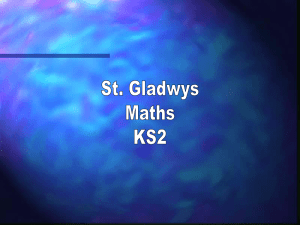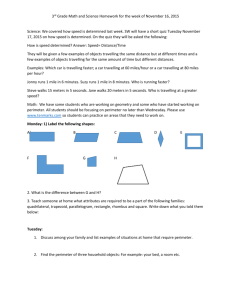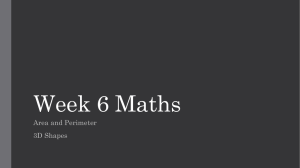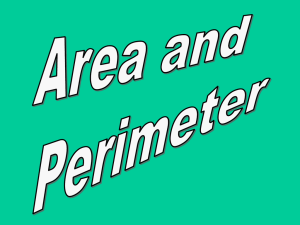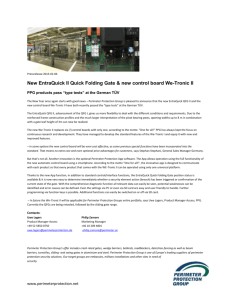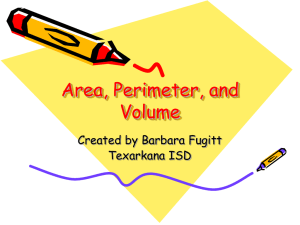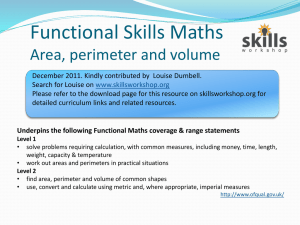Lesson Plan
advertisement
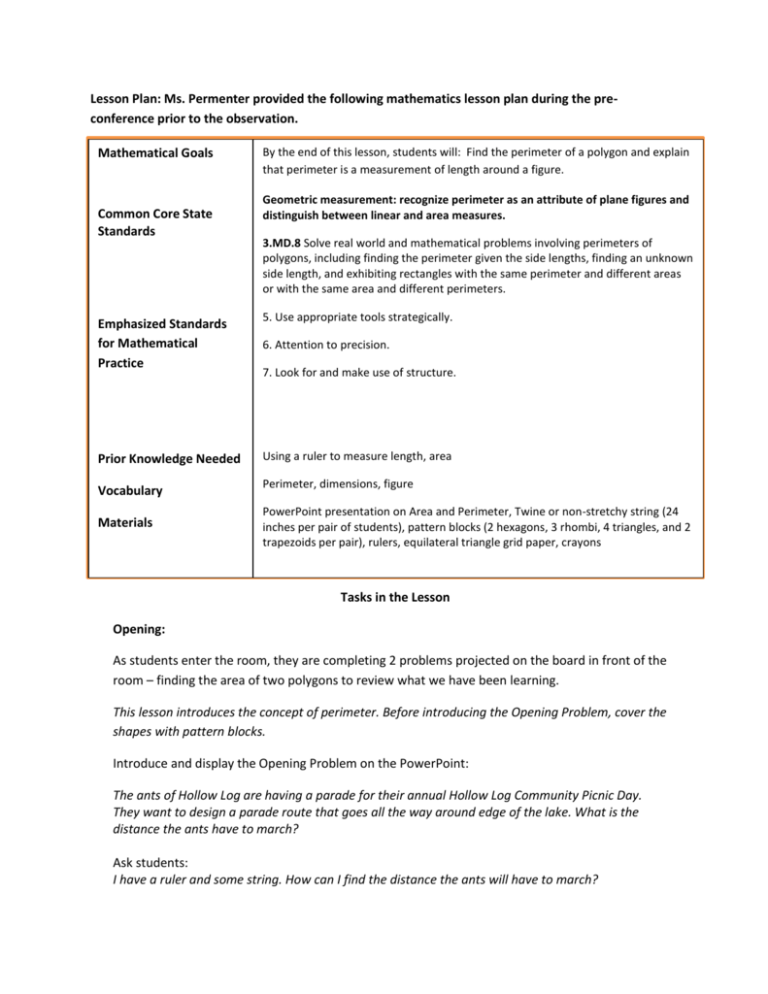
Lesson Plan: Ms. Permenter provided the following mathematics lesson plan during the preconference prior to the observation. Mathematical Goals Common Core State Standards Emphasized Standards for Mathematical Practice By the end of this lesson, students will: Find the perimeter of a polygon and explain that perimeter is a measurement of length around a figure. Geometric measurement: recognize perimeter as an attribute of plane figures and distinguish between linear and area measures. 3.MD.8 Solve real world and mathematical problems involving perimeters of polygons, including finding the perimeter given the side lengths, finding an unknown side length, and exhibiting rectangles with the same perimeter and different areas or with the same area and different perimeters. 5. Use appropriate tools strategically. 6. Attention to precision. 7. Look for and make use of structure. Prior Knowledge Needed Using a ruler to measure length, area Vocabulary Perimeter, dimensions, figure Materials PowerPoint presentation on Area and Perimeter, Twine or non-stretchy string (24 inches per pair of students), pattern blocks (2 hexagons, 3 rhombi, 4 triangles, and 2 trapezoids per pair), rulers, equilateral triangle grid paper, crayons Tasks in the Lesson Opening: As students enter the room, they are completing 2 problems projected on the board in front of the room – finding the area of two polygons to review what we have been learning. This lesson introduces the concept of perimeter. Before introducing the Opening Problem, cover the shapes with pattern blocks. Introduce and display the Opening Problem on the PowerPoint: The ants of Hollow Log are having a parade for their annual Hollow Log Community Picnic Day. They want to design a parade route that goes all the way around edge of the lake. What is the distance the ants have to march? Ask students: I have a ruler and some string. How can I find the distance the ants will have to march? Choose a student volunteer to demonstrate holding the pattern blocks while guiding the string around the figure. Demonstrate holding the string where the path ends and measuring the length on a ruler. Ask students: How long will the ants have to travel? How do you know? Explore: Students will work together to find the perimeter of a figure they build with pattern blocks. The string reinforces the idea of perimeter as the distance around a figure, and the teacher should ensure students are using the string and ruler at this point in the lesson. Distribute 1 copy triangle grid sheet per pair, rulers, string, and pattern blocks. Students will work with their regular math partners. Allow students to work together to: • build a lake using the pattern blocks – all touching sides must be the same length, no “tip to tip”, no holes • use string to measure around the lake • measure the string to determine the distance around the lake. • record and color the design on the grid paper Explain: The formal idea of perimeter is introduced here, as well as the relationships between area and perimeter, which will be explored more fully in following lessons. The students should be made aware of the fixed area of the pattern block figures, but the conversation should focus on the finding of the perimeter of the figure. Using a triangle as an alternative measuring tool to the string and ruler is also introduced here. Project “Perimeter” slide on the board. The word “perimeter” can be broken into two parts. So what do you think “perimeter” means? When we find the perimeter, we find the distance around a figure. How did we find the perimeter for Hollow Log Community Lake? Remind students that we used string and measured how far it was to go around the entire figure. How is finding perimeter different from finding area? Possible student responses: • “When we found the area, we found the amount of space the figure would cover.” • “When we found the area, we found the space inside. But the perimeter is about the outside of the shape.” • “When we found the perimeter, we measured around the figure, but the area we measured inside.” What is true about the areas of all of the lakes? How do you know? **Have a few students work with the class whole-group to order the papers least perimeter to greatest perimeter on the board. Who thinks they made the lake with the shortest perimeter? Who thinks they made the lake with the longest perimeter? Ask: How are these lakes alike? How are these lakes different? Elaborate: Students will experience an additional opportunity to explore perimeter as the distance around a figure. The relationship between area and perimeter is again explored. With a smaller set of pattern blocks, students should be able to build and measure the perimeter of more than one figure during this time. Distribute a second triangle grid sheet per pair. Direct students to modify their pattern block collections: For this activity, you need to use one hexagon, one trapezoid, two blue parallelograms, and three triangles. Please put the rest of the pieces away. Find all of the different lake shapes you can build with these pieces. Color them on the grid paper, find the perimeter for each shape, and cut them out. Allow students to work for about 10 minutes. As students finish cutting out figures, they should post them on the board in order from shortest perimeter to longest perimeter. Stop the activity after 10 minutes to allow time for discussion. Discuss: How can you describe the shapes with the shortest perimeters? How can you describe the shapes with the longest perimeters? Math Journal Have students respond to the journal prompt: 1. What is perimeter? 2. Use 3 pattern blocks to build a figure. Show how to find the perimeter of the figure. Assessment Anecdotal notes from oral questioning while working with partners Student self-assessment and group-assessment rubrics Math Journal Responses


